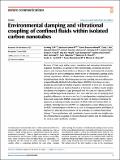| dc.contributor.author | Tu, Yu-Ming | |
| dc.contributor.author | Kuehne, Matthias | |
| dc.contributor.author | Misra, Rahul Prasanna | |
| dc.contributor.author | Ritt, Cody L | |
| dc.contributor.author | Oliaei, Hananeh | |
| dc.contributor.author | Faucher, Samuel | |
| dc.contributor.author | Li, Haokun | |
| dc.contributor.author | Xu, Xintong | |
| dc.contributor.author | Penn, Aubrey | |
| dc.contributor.author | Yang, Sungyun | |
| dc.contributor.author | Yang, Jing Fan | |
| dc.contributor.author | Sendgikoski, Kyle | |
| dc.contributor.author | Chakraverty, Joshika | |
| dc.contributor.author | Cumings, John | |
| dc.contributor.author | Majumdar, Arun | |
| dc.contributor.author | Aluru, Narayana R | |
| dc.contributor.author | Hachtel, Jordan A | |
| dc.contributor.author | Blankschtein, Daniel | |
| dc.contributor.author | Strano, Michael S | |
| dc.date.accessioned | 2024-11-21T22:58:01Z | |
| dc.date.available | 2024-11-21T22:58:01Z | |
| dc.date.issued | 2024 | |
| dc.identifier.uri | https://hdl.handle.net/1721.1/157658 | |
| dc.description.abstract | Because of their large surface areas, nanotubes and nanowires demonstrate exquisite mechanical coupling to their surroundings, promising advanced sensors and nanomechanical devices. However, this environmental sensitivity has resulted in several ambiguous observations of vibrational coupling across various experiments. Herein, we demonstrate a temperature-dependent Radial Breathing Mode (RBM) frequency in free-standing, electron-diffraction-assigned Double-Walled Carbon Nanotubes (DWNTs) that shows an unexpected and thermally reversible frequency downshift of 10 to 15%, for systems isolated in vacuum. An analysis based on a harmonic oscillator model assigns the distinctive frequency cusp, produced over 93 scans of 3 distinct DWNTs, along with the hyperbolic trajectory, to a reversible increase in damping from graphitic ribbons on the exterior surface. Strain-dependent coupling from self-tensioned, suspended DWNTs maintains the ratio of spring-to-damping frequencies, producing a stable saturation of RBM in the low-tension limit. In contrast, when the interior of DWNTs is subjected to a water-filling process, the RBM thermal trajectory is altered to that of a Langmuir isobar and elliptical trajectories, allowing measurement of the enthalpy of confined fluid phase change. These mechanisms and quantitative theory provide new insights into the environmental coupling of nanomechanical systems and the implications for devices and nanofluidic conduits.</jats:p> | en_US |
| dc.language.iso | en | |
| dc.publisher | Springer Science and Business Media LLC | en_US |
| dc.relation.isversionof | 10.1038/s41467-024-49661-8 | en_US |
| dc.rights | Creative Commons Attribution | en_US |
| dc.rights.uri | https://creativecommons.org/licenses/by/4.0/ | en_US |
| dc.source | Springer | en_US |
| dc.title | Environmental damping and vibrational coupling of confined fluids within isolated carbon nanotubes | en_US |
| dc.type | Article | en_US |
| dc.identifier.citation | Tu, YM., Kuehne, M., Misra, R.P. et al. Environmental damping and vibrational coupling of confined fluids within isolated carbon nanotubes. Nat Commun 15, 5605 (2024). | en_US |
| dc.contributor.department | Massachusetts Institute of Technology. Department of Chemical Engineering | en_US |
| dc.relation.journal | Nature Communications | en_US |
| dc.eprint.version | Final published version | en_US |
| dc.type.uri | http://purl.org/eprint/type/JournalArticle | en_US |
| eprint.status | http://purl.org/eprint/status/PeerReviewed | en_US |
| dc.date.updated | 2024-11-21T22:47:19Z | |
| dspace.orderedauthors | Tu, Y-M; Kuehne, M; Misra, RP; Ritt, CL; Oliaei, H; Faucher, S; Li, H; Xu, X; Penn, A; Yang, S; Yang, JF; Sendgikoski, K; Chakraverty, J; Cumings, J; Majumdar, A; Aluru, NR; Hachtel, JA; Blankschtein, D; Strano, MS | en_US |
| dspace.date.submission | 2024-11-21T22:47:26Z | |
| mit.journal.volume | 15 | en_US |
| mit.journal.issue | 1 | en_US |
| mit.license | PUBLISHER_CC | |
| mit.metadata.status | Authority Work and Publication Information Needed | en_US |
